The Intel Ivy Bridge (Core i7 3770K) Review
by Anand Lal Shimpi & Ryan Smith on April 23, 2012 12:03 PM EST- Posted in
- CPUs
- Intel
- Ivy Bridge
The Lineup: Quad-Core Only for Now
Very telling of how times have changed is that today's Ivy Bridge launch only comes with a single Extreme Edition processor—the Core i7-3920XM, a mobile part. There are some great enthusiast desktop parts of course, but as with Sandy Bridge the desktop Extreme Edition is reserved for another platform. In this case, we're talking about LGA-2011 which won't launch in an Ivy flavor until the end of this year/early next year at this point.
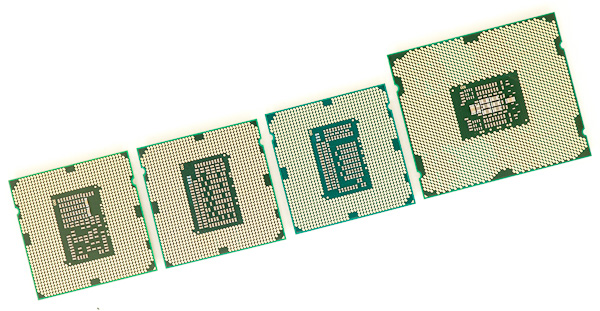
From left to right: Clarkdale, Sandy Bridge, Ivy Bridge, Sandy Bridge E
Contrary to everything I've been saying thus far however is the nature of the launch: only quad-core parts will be available first. The dual-core, and more importantly for Ivy Bridge, the ultra low voltage parts won't come until May/June. That means the bigger notebooks and naturally the performance desktops will arrive first, followed by the ultraportables, Ultrabooks and more affordable desktops. This strategy makes sense as the volumes for expensive quad-core notebooks and performance desktops in general are lower than cheaper dual-core notebooks/desktops. From what I've heard, the move to 22nm has been the most challenging transition Intel's fab teams have ever faced, which obviously constrains initial supplies.
| Intel 2012 CPU Lineup (Standard Power) | |||||||||
| Processor | Core Clock | Cores / Threads | L3 Cache | Max Turbo | Intel HD Graphics | TDP | Price | ||
| Intel Core i7 3960X | 3.3GHz | 6 / 12 | 15MB | 3.9GHz | N/A | 130W | $999 | ||
| Intel Core i7 3930K | 3.2GHz | 6 / 12 | 12MB | 3.8GHz | N/A | 130W | $583 | ||
| Intel Core i7 3820 | 3.6GHz | 4 / 8 | 10MB | 3.9GHz | N/A | 130W | $294 | ||
| Intel Core i7 3770K | 3.5GHz | 4 / 8 | 8MB | 3.9GHz | 4000 | 77W | $313 | ||
| Intel Core i7 3770 | 3.4GHz | 4 / 8 | 8MB | 3.9GHz | 4000 | 77W | $278 | ||
| Intel Core i5 3570K | 3.4GHz | 4 / 4 | 6MB | 3.8GHz | 4000 | 77W | $212 | ||
| Intel Core i5 3550 | 3.3GHz | 4 / 4 | 6MB | 3.7GHz | 2500 | 77W | $194 | ||
| Intel Core i5 3450 | 3.1GHz | 4 / 4 | 6MB | 3.5GHz | 2500 | 77W | $174 | ||
| Intel Core i7 2700K | 3.5GHz | 4 / 8 | 8MB | 3.9GHz | 3000 | 95W | $332 | ||
| Intel Core i5 2550K | 3.4GHz | 4 / 4 | 6MB | 3.8GHz | N/A | 95W | $225 | ||
| Intel Core i5 2500 | 3.3GHz | 4 / 4 | 6MB | 3.7GHz | 2000 | 95W | $205 | ||
| Intel Core i5 2400 | 3.1GHz | 4 / 4 | 6MB | 3.4GHz | 2000 | 95W | $195 | ||
| Intel Core i5 2320 | 3.0GHz | 4 / 4 | 6MB | 3.3GHz | 2000 | 95W | $177 | ||
There are five 77W desktop parts launching today, three 65W parts and one 45W part. The latter four are either T or S SKUs (lower leakage, lower TDP and lower clocked parts), while the first five are traditional, standard power parts. Note that max TDP for Ivy Bridge on the desktop has been reduced from 95W down to 77W thanks to Intel's 22nm process. The power savings do roughly follow that 18W decrease in TDP. Despite the power reduction, you may see 95W labels on boxes and OEMs are still asked to design for 95W as Ivy Bridge platforms can accept both 77W IVB and 95W Sandy Bridge parts.
We've already gone through Ivy's architecture in detail so check out our feature here for more details if you haven't already.
| Intel 2012 Additional CPU Features (Standard Power) | |||||||||
| Processor | GPU Clock (base) | GPU Clock (max) | PCIe 3.0 | Intel SIPP | Intel vPro | Intel VT-d | Intel TXT | ||
| Intel Core i7 3770K | 650MHz | 1150MHz | Yes | No | No | No | No | ||
| Intel Core i7 3770 | 650MHz | 1150MHz | Yes | Yes | Yes | Yes | Yes | ||
| Intel Core i5 3570K | 650MHz | 1150MHz | Yes | No | No | No | No | ||
| Intel Core i5 3550 | 650MHz | 1150MHz | Yes | Yes | Yes | Yes | Yes | ||
| Intel Core i5 3450 | 650MHz | 1100MHz | Yes | Yes | Yes | Yes | Yes | ||
The successful K-series SKUs are front and center in the Ivy lineup. As you'll remember from Sandy Bridge, anything with a K suffix ships fully unlocked. Ivy Bridge K-series SKUs support multipliers of up to 63x, an increase from the 57x maximum on Sandy Bridge. This won't impact most users unless you're doing any exotic cooling however.
If you don't have a K in your product name then your part is either partially or fully locked. Although this doesn't apply to any of the CPUs launching today, Ivy Bridge chips without support for turbo are fully locked and cannot be overclocked.
If your chip does support turbo boost, then you can overclock via increasing turbo ratios by as much as 4 bins above their standard setting. For example, the Core i7 3550 has a max turbo frequency of 3.7GHz with a single core active. Add another four bins (4 x 100MHz) and you get a maximum overclock of 4.1GHz, with one core active. The other turbo ratios can also be increased by up to four bins.
| Sandy Bridge vs. Ivy Bridge Pricing | |||||
| Sandy Bridge | Price | Price | Ivy Bridge | ||
| Core i7 2700K | $332 | $313 | Core i7 3770K | ||
| Core i7 2600 | $294 | $278 | Core i7 3770 | ||
| Core i5 2550K | $225 | $212 | Core i5 3750K | ||
| Core i5 2500 | $205 | $194 | Core i5 3550 | ||
| Core i5 2400 | $184 | $174 | Core i5 3450 | ||
The 3770K is the new king of the hill and it comes in $19 cheaper than the hill's previous resident: the Core i7 2700K. The non-K version saves you $16 compared to Sandy Bridge. The deltas continue down the line ranging ranging from $10—$19.
Unlike the Sandy Bridge launch, Intel is offering its high-end GPU on more than just K-series desktop parts right away. It is also differentiating K from non-K by adding another 100MHz to the base clock for K series parts. While the Core i7 2600K and Core i7 2600 both ran at 3.3GHz, the 3770 runs at 3.4GHz compared to the 3770K's 3.5GHz. It's a small difference but one that Intel hopes will help justify the added cost of the K.
Classic feature segmentation is alive and well with Ivy Bridge. In the quad-core lineup, only Core i7s get Hyper Threading—Core i5s do not. When the dual-core Core i3s show up in the coming months they will once again do so without support for turbo boost. Features like VT-d and Intel TXT are once again reserved for regular, non-K-series parts alone.


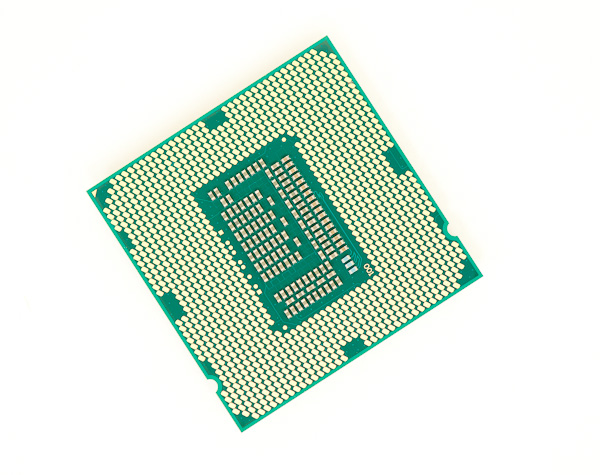
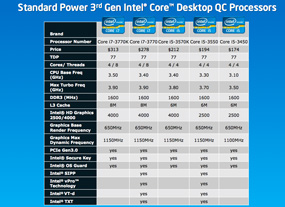
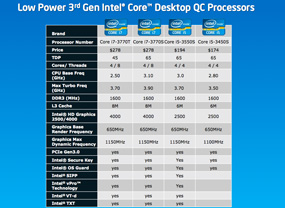
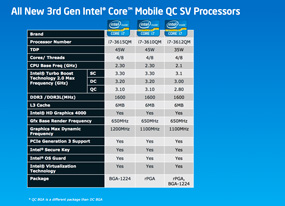
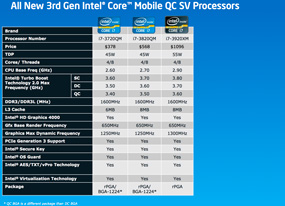








173 Comments
View All Comments
Tujan - Tuesday, April 24, 2012 - link
cause how I see it :" If you're constantly transcoding movies to get them onto your smartphone or tablet, you need Ivy Bridge. In less than 7 minutes, and with no impact to CPU usage, I was able to transcode a complete 130 minute 1080p video to an iPad friendly format—that's over 15x real time."
The majority of trancoding is going the other way- from an ipad friendly format to another friendly type format (device or not). Cell phone to pc,ipad to youtube etc.
I like the concept of the transcode,encode,but as much as with the bandwidth necesary to utilize them they are as they are 'bandwidth hungry'. And here is the first I have noticed that of telling there is hardware to facilitate the h.264 type encoding. "Hardware" to do this.
The screens from all of those cell phones in high resolution 'still'require bandwidth to utilize them. .. and so on.
I dont understand it completely but I'll attempt to stay tuned.
androticus - Tuesday, April 24, 2012 - link
I find this review enormously confusing. You mix IB and SB parts/sku's throughout, without clearly highlighting which is which. On page 2, at first I thought the chart was of IB CPUs, but then realized it was a mishmash of both. Likewise on all the benchmark charts, and I couldn't even distinguish various SB/IB/core counts apart.Was this article written solely for people who have a PhD in Intel sku's ???
Dudenell - Tuesday, April 24, 2012 - link
Could we actually see comparison with the i7-920 or i7-950 in there?Pjotr - Wednesday, April 25, 2012 - link
Thanks for the Compile test, this is all I look at to decide purchases at work.sld - Wednesday, April 25, 2012 - link
The A8 is conspicuously missing from the 2 charts showing idle and load system consumption. Why is this so?greggm2000 - Wednesday, April 25, 2012 - link
Anand/Ryan,According to the article linked below from today, it seems that Intel may be using TIM paste instead of fluxless solder in the IB chips, and if so, does this seem like a reasonable explanation for the high temperatures that people are seeing?
I'm interested in your thoughts on this... and if it's true, and if the article is correct, then Intel deliberately handicapping their chips (to possibly preserve SB-E sales?) is quite troubling to me.
http://www.overclockers.com/ivy-bridge-temperature...
slickr - Thursday, April 26, 2012 - link
Hi, is this good enough of an upgrade over a Pentium 4 for office, internet and movies?And will the HD4000 beat a ATI x1650XT?
Death666Angel - Friday, April 27, 2012 - link
Hey guys!Good review overall, thanks for that!
But the Quicksync section was kinda strange. No way that an x86 software solution generates worse IQ than any accelerated stuff. Unless you were comparing IQ with settings that have the x86 do recode the file in the same time it takes the other solutions. Anyway, I don't understand what you did in that section. :-)
kevith - Friday, April 27, 2012 - link
Great review.Would it be interesting to see how it fared in a series 6 motherboard, now that it actually is backwards compatible?
pwnsweet - Saturday, April 28, 2012 - link
The only thing I care about is how much faster this new slab of silicon will power though my x264 encoding and that's the one part of the review that was left out!Why anand, why!?